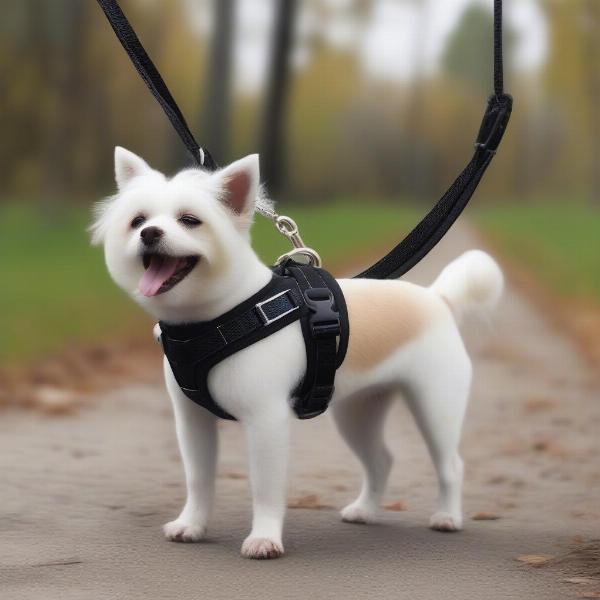Prong collars for small dogs are a controversial topic. While some owners and trainers find them effective tools for managing leash pulling and training certain behaviors, others express concerns about their potential for harm. This article aims to provide a balanced, evidence-based perspective on prong collars for small breeds, exploring their use, potential risks, and humane alternatives.
Understanding How Prong Collars Work
Prong collars, also known as pinch collars, consist of a series of blunt prongs that fit around a dog’s neck. When the dog pulls, the prongs tighten, creating pressure points around the neck. This pressure mimics the correction a mother dog might give her puppies, and proponents argue it can be a quick and effective way to deter unwanted behaviors like pulling. However, the sensation can be unpleasant and even painful if used incorrectly, making proper training and usage crucial.
Are Prong Collars Safe for Small Dogs?
The safety of prong collars, particularly for small breeds, is a significant concern. Their delicate necks and tracheas make them more susceptible to injury if the collar is used improperly or fitted too tightly. Choking, tracheal damage, and skin irritation are potential risks. Furthermore, the use of prong collars can create fear and anxiety in some dogs, leading to behavioral problems.
Proper Fit and Usage of Prong Collars for Small Breeds
If you choose to use a prong collar on a small dog, it’s vital to ensure a proper fit. The collar should sit high on the neck, just behind the ears, and be snug but not tight. You should be able to fit two fingers comfortably between the collar and the dog’s neck. Training with a prong collar should always be done under the guidance of a certified professional dog trainer who can demonstrate proper techniques and help you avoid causing harm to your dog.
Humane Alternatives to Prong Collars
Many humane and effective alternatives to prong collars exist for training small dogs. Harnesses, like front-clip harnesses, can redirect pulling without causing discomfort. Head halters provide gentle control over the dog’s head and direction. Positive reinforcement training methods, using rewards and praise, are often highly effective and build a strong bond between dog and owner.
 Small dog wearing a comfortable harness
Small dog wearing a comfortable harness
Considering the Dog’s Temperament
It’s essential to consider your small dog’s temperament before using any training tool, including a prong collar. For anxious or fearful dogs, a prong collar can exacerbate their anxiety and worsen their behavior. Positive reinforcement methods are generally a better approach for these dogs.
Consulting with a Professional
Before using a prong collar on your small dog, consult with a veterinarian or a certified professional dog trainer. They can assess your dog’s individual needs, recommend appropriate training methods, and help you make an informed decision.
Conclusion
Prong collars for small dogs require careful consideration. While they can be effective in certain situations when used correctly, they carry potential risks, especially for small breeds. Prioritize your dog’s well-being by exploring humane alternatives and seeking professional guidance. Proper training, a focus on positive reinforcement, and a commitment to your dog’s comfort and safety are essential for building a positive and rewarding relationship.
FAQ
- Are prong collars cruel for small dogs? Prong collars can be aversive and potentially harmful if misused. Their suitability depends on the dog’s individual needs and the owner’s ability to use them correctly under professional guidance.
- What size prong collar should I use for my small dog? Consult a professional trainer or veterinarian for proper sizing. Never guess or estimate the size.
- Can I use a prong collar on a puppy? Prong collars are generally not recommended for puppies due to their developing necks and tracheas.
- What are some alternatives to prong collars for leash pulling? Front-clip harnesses, head halters, and positive reinforcement training are effective alternatives.
- How do I train my small dog with a prong collar? Always work with a certified professional dog trainer who can guide you on proper techniques.
- Can a prong collar hurt my small dog? Yes, if used incorrectly, a prong collar can cause pain, injury, and psychological distress.
- Is a prong collar the best solution for my small dog’s behavioral issues? Not necessarily. Consult a professional to determine the best approach for your dog’s specific needs.
ILM Dog is a leading international pet website dedicated to providing expert advice on dog care and training. We offer a wealth of resources on breed selection, health care, training techniques, nutrition, grooming, exercise, puppy care, senior dog care, traveling with dogs, and product reviews. For further information or personalized guidance on finding the perfect products for your small dog, contact us at [email protected] or +44 20-3965-8624. ILM Dog is committed to helping you navigate the world of dog ownership and provide the best possible care for your furry friend.